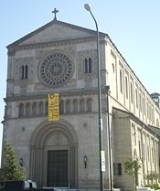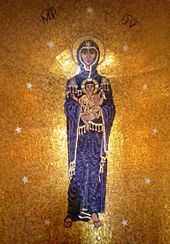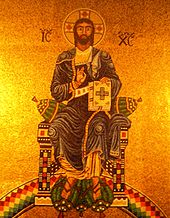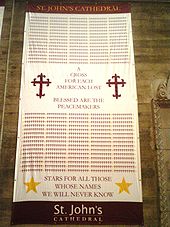
St. John's Cathedral, Los Angeles
Encyclopedia
St. John's Cathedral is an Episcopal church near Downtown Los Angeles
that serves both as a parish church and as a cathedral church for the Episcopal Diocese of Los Angeles
, an area covering five-and-a-half counties. Though St. John's was formed in 1890, the current Romanesque Revival
architectural style
church was built in 1925. It was listed in the National Register of Historic Places
in 2000.
reported on the groundbreaking ceremony in a front-page story:
 In 1913, George Davidson took over as rector at St. John's, a position he held until 1951. Davidson led the church during a period of tremendous growth, as membership rose from 400 to 2,300. Davidson was also a member of the faculty at USC for 14 years, served as president of the ASPCA
In 1913, George Davidson took over as rector at St. John's, a position he held until 1951. Davidson led the church during a period of tremendous growth, as membership rose from 400 to 2,300. Davidson was also a member of the faculty at USC for 14 years, served as president of the ASPCA
, and was one of the first organizers of the city's Community Chest drives. When Davidson retired in 1951 at age 71, more than 1,000 people attended his final service at St. John's. At the time, Davidson said, "In all humility, I express my gratitude. My prayers are for St. John's and may His blessing be upon all its loyal members who have raised its standard high. ... The joys and sorrows, the achievements and failures, the happiness and loneliness of many people during the years have been so woven into the fabric of my life that it is difficult for me to express adequately the mingling feelings of my heart in this solemn hour." Davidson died in July 1967 in Los Angeles.
 By 1920, St. John's had outgrown the existing church structure, and a contest to design the new church was won by brothers Pierpont and Walter Davis. The Davis brothers designed the church in an Italian neo-Romanesque
By 1920, St. John's had outgrown the existing church structure, and a contest to design the new church was won by brothers Pierpont and Walter Davis. The Davis brothers designed the church in an Italian neo-Romanesque
style modeled after the 11th century church of San Pietro in Tuscania
, about 75 miles northwest of Rome.
The new church opened in 1924, after two years of construction, and was consecrated in 1925. The Los Angeles Times reported that the last service in the old church was "rife with tender memories" and an "added charm and reverence pervaded the occasion." When the new church opened the following week, the Times called it "one of the most beautiful and costly edifices in the country." Another report noted: "Critics declare it the most beautiful in Los Angeles." Built at a cost of $650,000, the church was described at the time as a "close copy of an Italian church of the sixth century in built at Toscanella."
The church's walls are made of reinforced concrete two-and-a-half feet thick clear to the roof, and the structure is 69 feet from floor to ceiling. The wood-beamed ceiling is a reproduction of a church ceiling from the 11th century at San Miniato
, near Florence. The altar is made of Italian marble, and the triptych
was carved by Oberammergau
workmen. The interior includes a stained glass window featuring Martin Luther King, Jr.
, installed in 1977. Other windows include a Romanesque rose window
. Another striking feature of the church is found in the gold mosaics on the chapel walls. One mosaic depicts the Virgin Mary and Christ child modeled after a 13th century mosaic at the Cathedral of Santa Maria Assunta
in Torcello
, Italy. There is also a mosaic of Jesus as judge, holding a Bible and giving a blessing, a 12th-century convention.
At the time the new church opened in 1924, St. John's had 2,000 communicants on its membership list and was the largest Episcopal church west of Chicago.
In 1947, The Seven Angels mosaics were added to the church at a cost of $150,000. The figures of the angels, each eight feet high and holding a musical instrument, were made of Italian marble with gold mosaic and stand in arched panels. The mosaics were created in Italy by five artists who spent two years working on them.
 In 1970, Carter drew media attention when he closed the large ceremonial front doors of the church as a protest against the Vietnam War
In 1970, Carter drew media attention when he closed the large ceremonial front doors of the church as a protest against the Vietnam War
. He noted that the doors were closed "as a sign of our penitence and sorrow, as well as protest. Penitence for our silence and hence our part in the bloodshed. ... Protest that once again our beloved country has chosen guns and bombs instead of other means of reconciliation." The doors remained closed for three years until the war ended. At the April 1973 ceremony at which the doors were reopened, Carter noted, "This is no moment of triumph. We reopen our doors as an affirmation, to a peace ... which will offer mankind a new life on this planet." The ceremony was interspersed with the sounding of a shofar
, the ram's horn traditionally used in Jewish services. Though he considered the peace to be no more than an "armistice" enforced by the "terror of nuclear warheads," Carter said that the church "chose this moment to signify our thanksgiving that our bombers no longer rake the ravaged land, that our prisoners of war are finally home and our fighting forces withdrawn (from) an enterprise which drained the spiritual as well as the material resources of our land."
 In recent years, the St. John's community has actively voiced its opposition to the War in Iraq. Each Sunday, the names of each American military person who died in the war is read at the church's servics. A banner at the back of the church has a cross marked for each American death in the war. And during the procession
In recent years, the St. John's community has actively voiced its opposition to the War in Iraq. Each Sunday, the names of each American military person who died in the war is read at the church's servics. A banner at the back of the church has a cross marked for each American death in the war. And during the procession
of the palms during Palm Sunday
services, members of the congregation carried anti-war protest signs along with their palms.
announced that St. John's had been named the procathedral of the Diocese of Los Angeles, with the cathedral functions to be shared with the Cathedral Center of St. Paul in Echo Park. Larger diocesan liturgical functions are carried out at St. John's while all other diocesan offices and functions are located at St. Paul's. The dedication was held in February, 2008.
The Very Rev. Canon Mark Kowalewski, rector of St. John's, noted that the changes were the culmination of years of conversations. He noted that when the current church was first built in the 1920s, its first rector, Fr. Davidson had wanted it to become the diocesan cathedral.
Downtown Los Angeles
Downtown Los Angeles is the central business district of Los Angeles, California, United States, located close to the geographic center of the metropolitan area...
that serves both as a parish church and as a cathedral church for the Episcopal Diocese of Los Angeles
Episcopal Diocese of Los Angeles
The Episcopal Diocese of Los Angeles is a community of 85,000 Episcopalians in 147 congregations, 40 schools, and 18 major institutions, spanning all of Los Angeles, Orange, San Bernardino, Santa Barbara, and Ventura counties, and part of Riverside County....
, an area covering five-and-a-half counties. Though St. John's was formed in 1890, the current Romanesque Revival
Romanesque Revival architecture
Romanesque Revival is a style of building employed beginning in the mid 19th century inspired by the 11th and 12th century Romanesque architecture...
architectural style
Architectural style
Architectural styles classify architecture in terms of the use of form, techniques, materials, time period, region and other stylistic influences. It overlaps with, and emerges from the study of the evolution and history of architecture...
church was built in 1925. It was listed in the National Register of Historic Places
National Register of Historic Places
The National Register of Historic Places is the United States government's official list of districts, sites, buildings, structures, and objects deemed worthy of preservation...
in 2000.
Early history
St. John's was founded in 1890. The Los Angeles TimesLos Angeles Times
The Los Angeles Times is a daily newspaper published in Los Angeles, California, since 1881. It was the second-largest metropolitan newspaper in circulation in the United States in 2008 and the fourth most widely distributed newspaper in the country....
reported on the groundbreaking ceremony in a front-page story:
"Quite a large number of interested people assembled on foot and in carriages at the corner of Figueroa and Adams streets, at 4 p.m. yesterday, to witness the laying of the corner-stone St. John's Episcopal Church. The clergy, in their vestments, preceded by the vestry of the parish, came on the grounds in processsion, opening the service as they approached the building site. ... St. John's is to be a tasteful Gothic structure of brick, with stone facings, and wood, capable of seating 150 people. It is placed on the lot as to admit of the erection of a larger structure in the near future."The original neo-Gothic church was consecrated in June 1894.
George Davidson

American Society for the Prevention of Cruelty to Animals
The American Society for the Prevention of Cruelty to Animals is a non-profit organization dedicated to preventing cruelty towards animals...
, and was one of the first organizers of the city's Community Chest drives. When Davidson retired in 1951 at age 71, more than 1,000 people attended his final service at St. John's. At the time, Davidson said, "In all humility, I express my gratitude. My prayers are for St. John's and may His blessing be upon all its loyal members who have raised its standard high. ... The joys and sorrows, the achievements and failures, the happiness and loneliness of many people during the years have been so woven into the fabric of my life that it is difficult for me to express adequately the mingling feelings of my heart in this solemn hour." Davidson died in July 1967 in Los Angeles.
New church building

Romanesque Revival architecture
Romanesque Revival is a style of building employed beginning in the mid 19th century inspired by the 11th and 12th century Romanesque architecture...
style modeled after the 11th century church of San Pietro in Tuscania
Tuscania
Tuscania is a town and comune in the province of Viterbo, Lazio Region, Italy. Until the late 19th century the town was known as Toscanella.-Ancient times:...
, about 75 miles northwest of Rome.
The new church opened in 1924, after two years of construction, and was consecrated in 1925. The Los Angeles Times reported that the last service in the old church was "rife with tender memories" and an "added charm and reverence pervaded the occasion." When the new church opened the following week, the Times called it "one of the most beautiful and costly edifices in the country." Another report noted: "Critics declare it the most beautiful in Los Angeles." Built at a cost of $650,000, the church was described at the time as a "close copy of an Italian church of the sixth century in built at Toscanella."
The church's walls are made of reinforced concrete two-and-a-half feet thick clear to the roof, and the structure is 69 feet from floor to ceiling. The wood-beamed ceiling is a reproduction of a church ceiling from the 11th century at San Miniato
San Miniato
San Miniato is a town and comune in the province of Pisa, in the region of Tuscany, Italy.San Miniato sits at an historically strategic location atop three small hills where it dominates the lower Arno valley between the valleys of Egola and Elsa...
, near Florence. The altar is made of Italian marble, and the triptych
Triptych
A triptych , from tri-= "three" + ptysso= "to fold") is a work of art which is divided into three sections, or three carved panels which are hinged together and can be folded shut or displayed open. It is therefore a type of polyptych, the term for all multi-panel works...
was carved by Oberammergau
Oberammergau
Oberammergau is a municipality in the district of Garmisch-Partenkirchen, in Bavaria, Germany. The town is famous for its production of a Passion Play, its woodcarvers, and the NATO School.-Passion Play:...
workmen. The interior includes a stained glass window featuring Martin Luther King, Jr.
Martin Luther King, Jr.
Martin Luther King, Jr. was an American clergyman, activist, and prominent leader in the African-American Civil Rights Movement. He is best known for being an iconic figure in the advancement of civil rights in the United States and around the world, using nonviolent methods following the...
, installed in 1977. Other windows include a Romanesque rose window
Rose window
A Rose window is often used as a generic term applied to a circular window, but is especially used for those found in churches of the Gothic architectural style and being divided into segments by stone mullions and tracery...
. Another striking feature of the church is found in the gold mosaics on the chapel walls. One mosaic depicts the Virgin Mary and Christ child modeled after a 13th century mosaic at the Cathedral of Santa Maria Assunta
Cathedral of Santa Maria Assunta
The Cathedral of Santa Maria Assunta is a basilica church on the island of Torcello, Venice, northern Italy...
in Torcello
Torcello
Torcello is a quiet and sparsely populated island at the northern end of the Venetian Lagoon. It is considered the oldest continuously populated region of Venice, and once held the largest population of the Republic of Venice.-History:...
, Italy. There is also a mosaic of Jesus as judge, holding a Bible and giving a blessing, a 12th-century convention.
At the time the new church opened in 1924, St. John's had 2,000 communicants on its membership list and was the largest Episcopal church west of Chicago.
In 1947, The Seven Angels mosaics were added to the church at a cost of $150,000. The figures of the angels, each eight feet high and holding a musical instrument, were made of Italian marble with gold mosaic and stand in arched panels. The mosaics were created in Italy by five artists who spent two years working on them.
Lawrence Carter's "metropolitan church"
From 1958 to 1974, the Rev. E. Lawrence Carter was the rector at St. John's. During his tenure, the surrounding area changed from one of white affluence to racially mixed poverty. "Carter led the church in changing with it, moving from an upper-level parish church controlled by businessmen to what he termed a metropolitan church welcoming leaders of many races and economic backgrounds." In 1973, Carter recalled: "There never was a mass exodus, a confrontation, nothing like that. Just a slow ebbing, a dilution socially, economically, racially." He described his concept of a "metropolitan church" as the need for an urban church "to do the social bit". He noted, "Mainline churches cannot be the church unless they pay attention to the community where they are. The church must be involved in all the areas of life." During his time as rector, Carter founded the St. John's Well Child Center and also worked to aid the homeless.Doors closed as protest to Vietnam War

Vietnam War
The Vietnam War was a Cold War-era military conflict that occurred in Vietnam, Laos, and Cambodia from 1 November 1955 to the fall of Saigon on 30 April 1975. This war followed the First Indochina War and was fought between North Vietnam, supported by its communist allies, and the government of...
. He noted that the doors were closed "as a sign of our penitence and sorrow, as well as protest. Penitence for our silence and hence our part in the bloodshed. ... Protest that once again our beloved country has chosen guns and bombs instead of other means of reconciliation." The doors remained closed for three years until the war ended. At the April 1973 ceremony at which the doors were reopened, Carter noted, "This is no moment of triumph. We reopen our doors as an affirmation, to a peace ... which will offer mankind a new life on this planet." The ceremony was interspersed with the sounding of a shofar
Shofar
A shofar is a horn, traditionally that of a ram, used for Jewish religious purposes. Shofar-blowing is incorporated in synagogue services on Rosh Hashanah and Yom Kippur.Shofar come in a variety of sizes.- Bible and rabbinic literature :...
, the ram's horn traditionally used in Jewish services. Though he considered the peace to be no more than an "armistice" enforced by the "terror of nuclear warheads," Carter said that the church "chose this moment to signify our thanksgiving that our bombers no longer rake the ravaged land, that our prisoners of war are finally home and our fighting forces withdrawn (from) an enterprise which drained the spiritual as well as the material resources of our land."

Procession
A procession is an organized body of people advancing in a formal or ceremonial manner.-Procession elements:...
of the palms during Palm Sunday
Palm Sunday
Palm Sunday is a Christian moveable feast that falls on the Sunday before Easter. The feast commemorates Jesus' triumphal entry into Jerusalem, an event mentioned in all four Canonical Gospels. ....
services, members of the congregation carried anti-war protest signs along with their palms.
Designation as procathedral
In October 2007, Bishop J. Jon BrunoJ. Jon Bruno
J. Jon Bruno is the Episcopal Bishop of Los Angeles.-Early life and education:Joseph Jon Bruno was born in Los Angeles November 17, 1946 to Dorothy and Joseph J. Bruno...
announced that St. John's had been named the procathedral of the Diocese of Los Angeles, with the cathedral functions to be shared with the Cathedral Center of St. Paul in Echo Park. Larger diocesan liturgical functions are carried out at St. John's while all other diocesan offices and functions are located at St. Paul's. The dedication was held in February, 2008.
The Very Rev. Canon Mark Kowalewski, rector of St. John's, noted that the changes were the culmination of years of conversations. He noted that when the current church was first built in the 1920s, its first rector, Fr. Davidson had wanted it to become the diocesan cathedral.
Rectors
- The Rev. H. O. Judd, May 6, 1890–May 1891
- The Rev. W. B. R. Tayler, December 13, 1891–April 17, 1903
- The Rev. Lawrence B. Ridgely, May 31, 1903–April 23, 1905
- The Rev. Lewis Grouverneur Morris, September 10, 1905–October 1912
- The Rev. George Davidson, April 1913–October 1, 1951
- The Rev. Ray Holder, December 1951–August 15, 1955
- The Rev. Robert Quayle Kennaugh, December 1955–1958
- The Rev. E. Lawrence Carter, 1958–1974
- The Rt. Rev. William D. Persell, 1973–1982
- The Rev. Warner Traynham, 1982?–2006?
- The Very Rev. Canon Mark Kowalewski, 2006–present
- The Very Rev. Canon Daniel Ade, 2010–present
See also
- List of cathedrals in the United States
- List of Registered Historic Places in Los Angeles
- List of Los Angeles Historic-Cultural Monuments in South Los Angeles
External links
- St. John's Episcopal Church website
- Cathedrals of California
- "The making of a cathedral: an interview with Fr. Mark", St. John's Cathedral News, December 2007.

